ok crank HP from rwhp #s
#21
TECH Fanatic
Join Date: Aug 2009
Location: Coast of San Mateo County Between Pacifica & HMB
Posts: 1,822
Received 225 Likes
on
132 Posts

Good article on Facebook about drivetrain losses, not a member yet
But should be easy enough to find.
Posted before I saw Spanks post, lots of overlap with facebook
Article.
But should be easy enough to find.
Posted before I saw Spanks post, lots of overlap with facebook
Article.
Last edited by NAVYBLUE210; 05-15-2017 at 05:53 PM.
#22
Banned
iTrader: (1)
So the best way to figure out crank horsepower is yank the motor & put it on an engine dyno. Otherwise we're just trying to make good guesses.
Hey kingtal0n, who taught you math? You say "there is no such thing as division, its really just a form of multiplication"? Sorry but that's pretty stoopid. That's like " there is no such thing as subtraction, it's really just a form of addition". Try not to get stuck in the rabbit hole.
Hey kingtal0n, who taught you math? You say "there is no such thing as division, its really just a form of multiplication"? Sorry but that's pretty stoopid. That's like " there is no such thing as subtraction, it's really just a form of addition". Try not to get stuck in the rabbit hole.
Showing how the world's numbers work from different perspectives gives insight, new ways of thinking about the same old ideas. You are absolutely correct that I also say there is no such thing as subtraction. When dealing with terms, signs, and properties as a new-to-math, I find it helps to minimize the amount of memorization and focus on the problem solving aspects. Trying to memorize the rules of addition or subtraction, for example, is only going to work for a short time until the student takes a calculus type course, where most of that 'work' should be automatically/internally done by 'feel'.
The surest way to corrupt a youth is to instruct him to hold in higher esteem those who think alike than those who think differently. Friedrich Nietzsche
#23
Well I have to say measuring Drivetrain lost using data from Engine Dyno crank HP and RWHP from a Chassis Dyno is BS. It can't be done.
Everyone is ignoring the obvious.
In order to do even a have a remote chance of that happening the, Intake components an Exhaust System components would have to be the same. Engine Dyno optimal. Car not optimal.
Want to pick up a few more HP/TQ on a Chassis Dyno, you swap out the restrictive Factory intake system for a more efficient system. Not Drivetrain related. HP changed, drivetrain didn't but BS percentage did.
Question still remains, does that aftermarket system matchup with what was if any was used when Engine was on Engine Dyno?
Want to make even more HP/TQ, what's the next change you make? You swap out the restrictive factory exhaust manifolds and replace them with higher flowing aftermarket headers and exhaust pipes. Did the exhaust system that came on car match that used when Engine was on the Engine Dyno?
Next is Software differences between Dyno Manufactures to compute HP/TQ. SAE Corrected Dyno numbers should be the same, but we all know that's not the case. Example DynoJet Dyno Corrected HP/TQ numbers and Mustang Dyno Corrected numbers will not be the same.
So even if both Dynos were sitting side by side and car Dyno on both on the same day, under the same conditions you would not get the same Percentage of Drivetrain lost, nor would you get the more important HP to Weight of Car numbers. Only thing you get is a better set of Bragging Numbers form one than you get from the other one...LOL
Case in point, GM's LS3 Hot Cam 480 HP rated engine in my car.
On a DynoJet Chassis Dyno, HP number is 409 SAE corrected RWHP, that's a 15% lost of HP, supposedly due to Drivetrain parasitic lost only from Engines 480 SAE HP rating, if you believed some of what I've read on this Thread.
On a Mustang Dyno same engine, same setup made 360 SAE corrected RWHP, that's a 25% HP lost supposedly due to Drivetrain parasitic lost from Engine 480SAE HP rating.
Two different HP lost Percentages, but how much of that lost was due to Drivetrain?
Two things I can tell you for sure is the Air Intake system of engine in my car is not optimal per GM, and same can be said for Exhaust system per Aftermarket.
Air intake is nowhere near what GM says is needed for engine's air intake needs. It's two 3.0" dia tubes, joined together and within a space of about 3 inches, stepped up to 3.5" dia, then to 4.0" dia tube with MAF right before throttle body.
Exhaust system wise the header tubes are too small, 1 3/4" Vs recommended 1 7/8" tubes. Rest of system No cats, 3.0" exhaust pipes with X pipe, and Billy Boat C6 Vette NPP mufflers.
Intake
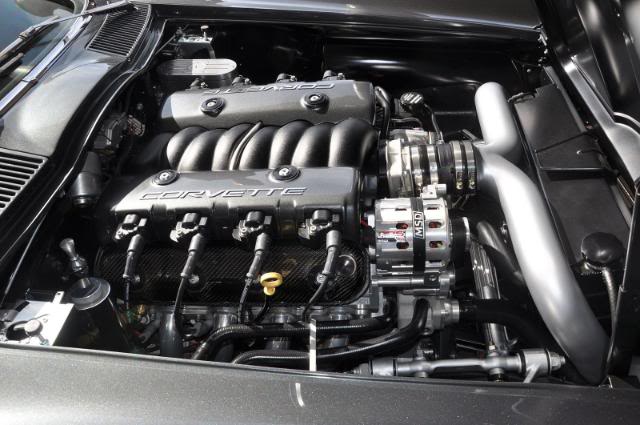
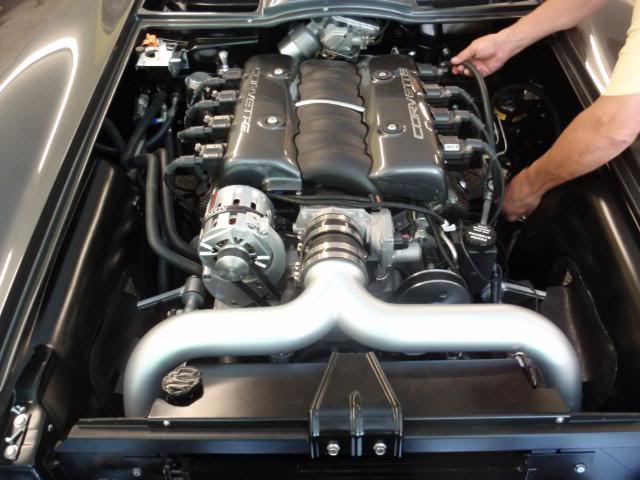
Exhaust

Weight of car as raced without me in it, approximately 4 gallons of fuel.
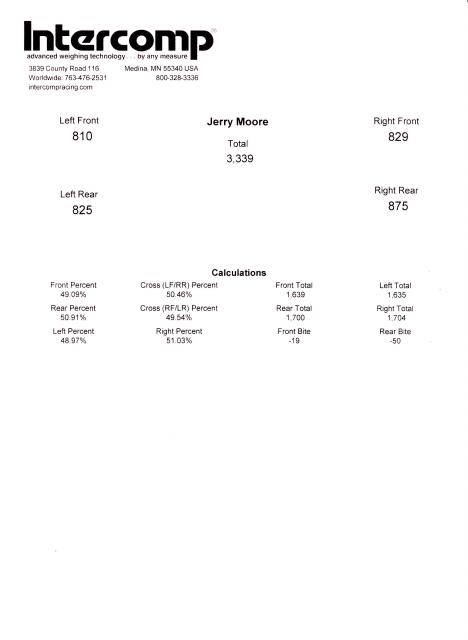
Weight of car as raced with me in it, approximately 4 gallons of fuel.
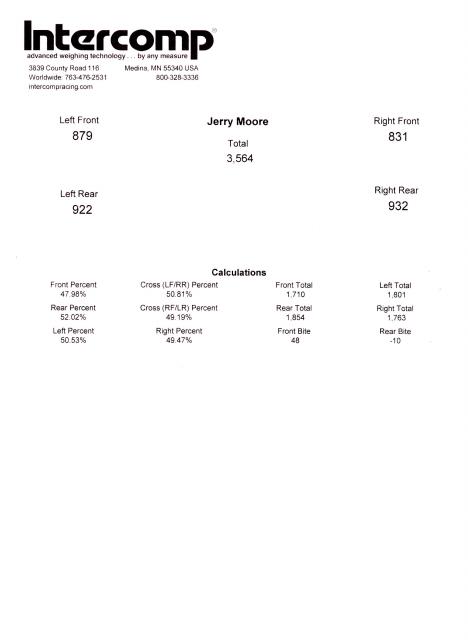
Two ways to get the same performance. HP to Vehicle's Weight or Reduce Weight to engine's HP. Both will produce the same HP to Weight, same performance potential all things considered.
Time Slip. (Car as raced 300 TW street tires, no DR's or Slicks, 3.55 Rear Gear, Transmission 4L80E 4sp Automatic converted to 6sp (TCI 6X), TQ converter muilty Disc, approximate stock stall, high STR.) Plug the below numbers into any 1/4 mile time calculator, and they say car at best is a 12.5 ET car for the most part.
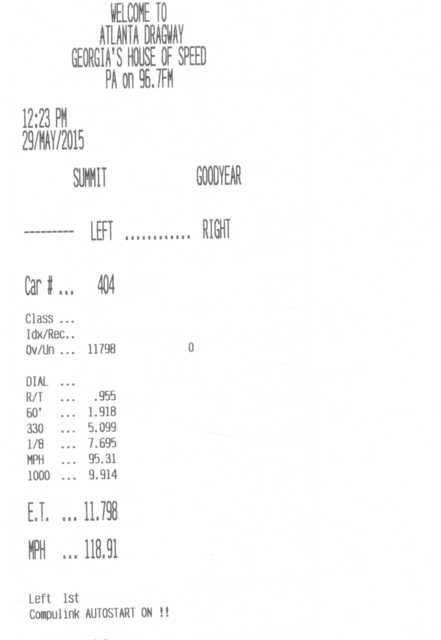
Sum Up:
Two different dyno Mfg, Two different Driveline Lost Percentages.
DynoJet dyno numbers driveline lost percentage = 15%
Mustang Dyno numbers driveline lost percentage = 25%
Three different dyno HP to Weight ratios.
Engine Dyno SAE HP to Weight ratio = 7.42 lbs per HP
DynoJet Dyno numbers HP to Weight ratio = 8.8 lbs per HP
Mustang Dyno numbers HP to Weight ratio = 9.9 lbs per HP
Drivetrain lost for the most part is built in. About only thing you can do is swap out any components you can for ones with less mass weight, and cross your fingers.
Car's HP to Weight ratio is far more important in determining car performance potential. Makes me wonder why so many don't know what their car's weight is so they can build or buy a crate engine with Crank HP they need to go the time and speed they want for car with transmission and rear end gearing they are going to be using.
Note: All of the above is based on use of Fuzzy Logic by an old senile High School Dropout.
Everyone is ignoring the obvious.
In order to do even a have a remote chance of that happening the, Intake components an Exhaust System components would have to be the same. Engine Dyno optimal. Car not optimal.
Want to pick up a few more HP/TQ on a Chassis Dyno, you swap out the restrictive Factory intake system for a more efficient system. Not Drivetrain related. HP changed, drivetrain didn't but BS percentage did.
Question still remains, does that aftermarket system matchup with what was if any was used when Engine was on Engine Dyno?
Want to make even more HP/TQ, what's the next change you make? You swap out the restrictive factory exhaust manifolds and replace them with higher flowing aftermarket headers and exhaust pipes. Did the exhaust system that came on car match that used when Engine was on the Engine Dyno?
Next is Software differences between Dyno Manufactures to compute HP/TQ. SAE Corrected Dyno numbers should be the same, but we all know that's not the case. Example DynoJet Dyno Corrected HP/TQ numbers and Mustang Dyno Corrected numbers will not be the same.
So even if both Dynos were sitting side by side and car Dyno on both on the same day, under the same conditions you would not get the same Percentage of Drivetrain lost, nor would you get the more important HP to Weight of Car numbers. Only thing you get is a better set of Bragging Numbers form one than you get from the other one...LOL
Case in point, GM's LS3 Hot Cam 480 HP rated engine in my car.
On a DynoJet Chassis Dyno, HP number is 409 SAE corrected RWHP, that's a 15% lost of HP, supposedly due to Drivetrain parasitic lost only from Engines 480 SAE HP rating, if you believed some of what I've read on this Thread.
On a Mustang Dyno same engine, same setup made 360 SAE corrected RWHP, that's a 25% HP lost supposedly due to Drivetrain parasitic lost from Engine 480SAE HP rating.
Two different HP lost Percentages, but how much of that lost was due to Drivetrain?
Two things I can tell you for sure is the Air Intake system of engine in my car is not optimal per GM, and same can be said for Exhaust system per Aftermarket.
Air intake is nowhere near what GM says is needed for engine's air intake needs. It's two 3.0" dia tubes, joined together and within a space of about 3 inches, stepped up to 3.5" dia, then to 4.0" dia tube with MAF right before throttle body.
Exhaust system wise the header tubes are too small, 1 3/4" Vs recommended 1 7/8" tubes. Rest of system No cats, 3.0" exhaust pipes with X pipe, and Billy Boat C6 Vette NPP mufflers.
Intake


Exhaust

Weight of car as raced without me in it, approximately 4 gallons of fuel.

Weight of car as raced with me in it, approximately 4 gallons of fuel.

Two ways to get the same performance. HP to Vehicle's Weight or Reduce Weight to engine's HP. Both will produce the same HP to Weight, same performance potential all things considered.
Time Slip. (Car as raced 300 TW street tires, no DR's or Slicks, 3.55 Rear Gear, Transmission 4L80E 4sp Automatic converted to 6sp (TCI 6X), TQ converter muilty Disc, approximate stock stall, high STR.) Plug the below numbers into any 1/4 mile time calculator, and they say car at best is a 12.5 ET car for the most part.

Sum Up:
Two different dyno Mfg, Two different Driveline Lost Percentages.
DynoJet dyno numbers driveline lost percentage = 15%
Mustang Dyno numbers driveline lost percentage = 25%
Three different dyno HP to Weight ratios.
Engine Dyno SAE HP to Weight ratio = 7.42 lbs per HP
DynoJet Dyno numbers HP to Weight ratio = 8.8 lbs per HP
Mustang Dyno numbers HP to Weight ratio = 9.9 lbs per HP
Drivetrain lost for the most part is built in. About only thing you can do is swap out any components you can for ones with less mass weight, and cross your fingers.
Car's HP to Weight ratio is far more important in determining car performance potential. Makes me wonder why so many don't know what their car's weight is so they can build or buy a crate engine with Crank HP they need to go the time and speed they want for car with transmission and rear end gearing they are going to be using.
Note: All of the above is based on use of Fuzzy Logic by an old senile High School Dropout.

Last edited by poorhousenext; 05-19-2017 at 09:26 PM.
#24
Moderator
iTrader: (4)
Join Date: Jul 2014
Location: My own internal universe
Posts: 10,452
Received 1,851 Likes
on
1,152 Posts

#25
Banned
iTrader: (1)
Time only looks the way it does because of our 3rd dimension observation.
Its all about perspective.
http://boards.straightdope.com/sdmb/...8&postcount=14
Its all about perspective.
http://boards.straightdope.com/sdmb/...8&postcount=14
:sigh:
24 Sept 1964 _Syracuse(NY) Post-Standard_ 34/4
The entertainment column, Lyons Den, authored by Leonard Lyons, a contemporary of Walter Winchell, and in the same business.
Quote:
An Insiders Newsletter emissary saw the ancient sign on a Berlin beer hall "God is Dead--Nietzsche. Under it had been added, "Nietzsche is dead -God"
24 Sept 1964 _Syracuse(NY) Post-Standard_ 34/4
The entertainment column, Lyons Den, authored by Leonard Lyons, a contemporary of Walter Winchell, and in the same business.
Quote:
An Insiders Newsletter emissary saw the ancient sign on a Berlin beer hall "God is Dead--Nietzsche. Under it had been added, "Nietzsche is dead -God"
#26
Moderator
iTrader: (4)
Join Date: Jul 2014
Location: My own internal universe
Posts: 10,452
Received 1,851 Likes
on
1,152 Posts

Originally Posted by kingtal0n
Time only looks the way it does because of our 3rd dimension observation.
Its all about perspective.
http://boards.straightdope.com/sdmb/...8&postcount=14
Its all about perspective.
http://boards.straightdope.com/sdmb/...8&postcount=14
#27
TECH Senior Member
Good job, Darth, keep him straight! Somebody has to....
#29
TECH Senior Member
Time only looks the way it does because of our 3rd dimension observation.
Its all about perspective.
http://boards.straightdope.com/sdmb/...8&postcount=14
Its all about perspective.
http://boards.straightdope.com/sdmb/...8&postcount=14
#30
TECH Addict
iTrader: (13)
Yep, nothing neat, clean, or linear about this - only rules of thumb and reasonable estimates. Few can/will put in the time and money to accurately and precisely answer this, especially across platforms. I can tell you f-body m6 rule of 15% is pretty good, 18% A4 good too. IRS slightly less efficient than solid rear the sedans suffer a bit. A light driveshaft or going from 2 piece to one or replacing rubber with poly will all help a little. High stalls = slippage = some dyno loss. Big rears (Dana, 9", 12bolt) cause some loss, as do big trans like T400s or 4L80s. Big tires, lose. Lighter wheels/tires, gain. Lighter flywheel =gain. You get the picture. This is a big topic, how much of it matters to you? Best thing you can do is engine dyno, then chassis dyno...then you know how much YOUR driveline costs you as a system at what RPMs.
For the record, chronos time is linear. Kairos time is...something else. The more you get into it, you start to see how science (esp quantum mechanics) lines up with the Bible. Should we start a separate topic in the lounge?
For the record, chronos time is linear. Kairos time is...something else. The more you get into it, you start to see how science (esp quantum mechanics) lines up with the Bible. Should we start a separate topic in the lounge?

#31
Banned
iTrader: (1)
Entropy in terms of life is quite different. Trapping ions and molecules inside of cells is always temporary, as cells have innumerable entrances and exits, pumps and machinery, and areas of segregation where only certain activities are supposed to occur. Depends on the type of cell, but they all follow traditional DNA->RNA->protein, whether bacterial or multicellular or protozoan. Entropy acting on a cell is what changes the fidelity of it's DNA library, eventually leading to dysfunction. Life is actually anti-entropy, that is, it seeks to provide order against the increasing chaos. So to say as time moves forward that entropy is increasing is not always true, and life is the perfect example for it exists because it provides negative entropy, the ordering and organizing effect in an environment where everything non-living seems to be randomizing and dis-organizing. So we have seen two good examples where time, as it proceeds, does not provide an increase in entropy, but rather may hold it still, or even reverse it, as process permits.
#32
Restricted User
That derailed quickly lol.
The differences between a dynojet and Mustang dyno numbers are not being of different manufacturer software. Math is math. The difference is hardware. Inertia dyno vs loaded dyno. On a dynojet, you are free-spinning a large heavy roller. Once it builds inertia, its much easier to spin and maintain constant speed. On a Mustang dyno, a large electric motor acts as a brake and provides a load for the tires to fight against. Measured HP will be very different between the two, as the Mustang dyno attempts to compensate for overall vehicle load to measure net output. A dynojet measures engine HP minus drivetrain loss and not much else. Basically, you're adding more mass with a Mustang dyno. Hence the higher % loss.
Well I have to say measuring Drivetrain lost using data from Engine Dyno crank HP and RWHP from a Chassis Dyno is BS. It can't be done.
Next is Software differences between Dyno Manufactures to compute HP/TQ. SAE Corrected Dyno numbers should be the same, but we all know that's not the case. Example DynoJet Dyno Corrected HP/TQ numbers and Mustang Dyno Corrected numbers will not be the same.
So even if both Dynos were sitting side by side and car Dyno on both on the same day, under the same conditions you would not get the same Percentage of Drivetrain lost, nor would you get the more important HP to Weight of Car numbers. Only thing you get is a better set of Bragging Numbers form one than you get from the other one...LOL
Case in point, GM's LS3 Hot Cam 480 HP rated engine in my car.
On a DynoJet Chassis Dyno, HP number is 409 SAE corrected RWHP, that's a 15% lost of HP, supposedly due to Drivetrain parasitic lost only from Engines 480 SAE HP rating, if you believed some of what I've read on this Thread.
On a Mustang Dyno same engine, same setup made 360 SAE corrected RWHP, that's a 25% HP lost supposedly due to Drivetrain parasitic lost from Engine 480SAE HP rating.
Two different HP lost Percentages, but how much of that lost was due to Drivetrain?
Sum Up:
Two different dyno Mfg, Two different Driveline Lost Percentages.
DynoJet dyno numbers driveline lost percentage = 15%
Mustang Dyno numbers driveline lost percentage = 25%
Three different dyno HP to Weight ratios.
Engine Dyno SAE HP to Weight ratio = 7.42 lbs per HP
DynoJet Dyno numbers HP to Weight ratio = 8.8 lbs per HP
Mustang Dyno numbers HP to Weight ratio = 9.9 lbs per HP
Drivetrain lost for the most part is built in. About only thing you can do is swap out any components you can for ones with less mass weight, and cross your fingers.
Note: All of the above is based on use of Fuzzy Logic by an old senile High School Dropout.
Next is Software differences between Dyno Manufactures to compute HP/TQ. SAE Corrected Dyno numbers should be the same, but we all know that's not the case. Example DynoJet Dyno Corrected HP/TQ numbers and Mustang Dyno Corrected numbers will not be the same.
So even if both Dynos were sitting side by side and car Dyno on both on the same day, under the same conditions you would not get the same Percentage of Drivetrain lost, nor would you get the more important HP to Weight of Car numbers. Only thing you get is a better set of Bragging Numbers form one than you get from the other one...LOL
Case in point, GM's LS3 Hot Cam 480 HP rated engine in my car.
On a DynoJet Chassis Dyno, HP number is 409 SAE corrected RWHP, that's a 15% lost of HP, supposedly due to Drivetrain parasitic lost only from Engines 480 SAE HP rating, if you believed some of what I've read on this Thread.
On a Mustang Dyno same engine, same setup made 360 SAE corrected RWHP, that's a 25% HP lost supposedly due to Drivetrain parasitic lost from Engine 480SAE HP rating.
Two different HP lost Percentages, but how much of that lost was due to Drivetrain?
Sum Up:
Two different dyno Mfg, Two different Driveline Lost Percentages.
DynoJet dyno numbers driveline lost percentage = 15%
Mustang Dyno numbers driveline lost percentage = 25%
Three different dyno HP to Weight ratios.
Engine Dyno SAE HP to Weight ratio = 7.42 lbs per HP
DynoJet Dyno numbers HP to Weight ratio = 8.8 lbs per HP
Mustang Dyno numbers HP to Weight ratio = 9.9 lbs per HP
Drivetrain lost for the most part is built in. About only thing you can do is swap out any components you can for ones with less mass weight, and cross your fingers.
Note: All of the above is based on use of Fuzzy Logic by an old senile High School Dropout.

#33
That derailed quickly lol.
The differences between a dynojet and Mustang dyno numbers are not being of different manufacturer software. Math is math. The difference is hardware. Inertia dyno vs loaded dyno. On a dynojet, you are free-spinning a large heavy roller. Once it builds inertia, its much easier to spin and maintain constant speed. On a Mustang dyno, a large electric motor acts as a brake and provides a load for the tires to fight against. Measured HP will be very different between the two, as the Mustang dyno attempts to compensate for overall vehicle load to measure net output. A dynojet measures engine HP minus drivetrain loss and not much else. Basically, you're adding more mass with a Mustang dyno. Hence the higher % loss.
The differences between a dynojet and Mustang dyno numbers are not being of different manufacturer software. Math is math. The difference is hardware. Inertia dyno vs loaded dyno. On a dynojet, you are free-spinning a large heavy roller. Once it builds inertia, its much easier to spin and maintain constant speed. On a Mustang dyno, a large electric motor acts as a brake and provides a load for the tires to fight against. Measured HP will be very different between the two, as the Mustang dyno attempts to compensate for overall vehicle load to measure net output. A dynojet measures engine HP minus drivetrain loss and not much else. Basically, you're adding more mass with a Mustang dyno. Hence the higher % loss.
You say "Measured HP will be very different between the two".
You state how each MFG Dyno works, one being "Inertia", while the other one is "Load".
Would you not agree with me that the "Software each Manufacture uses, would not and could not be the same as the "Math Equation(s) embedded in each "Software" used would and could not be the same, because neither uses the same approach to obtain their final output "HP/TQ" numbers. Math is still Math, but are you saying the "Equation(s)" used in each Manufacture's "Software that produce their HP/TQ numbers is the same, based on your statement, Dynojet uses inertia and measures HP, and the Mustang uses "load", along with statement "Mustang Dyno attempts to compensate for "overall vehicle load".
Could you explain to me what "overall vehicle load" includes? Surly it couldn't include the "Load/Weight of car or even that of the load on the rear tires of car. Maybe I could get higher HP numbers if I readjusted the suspension so that only 50 or 51% of cars weight was on rear tires instead of the 52% on them with me in the car...LOL
Again I go back to what's hampering HP/TQ numbers on my car. One reason I used that car as an example is neither the intake or exhaust systems is optimized. That's an LS3 engine in car.
Look closely at the intake, right before the throttle body. Do you see a LS3/7 Bayonet style MAF sensor? No the MAF sensor is a Stock (not even punched out Honeycomb) LS2 one. So not only is there not a 4.0" tube feeding air to engine, I've got a restrictive LS2 MAF hampering intake air flow to engine.
Now GM's SAE numbers are 480HP, Dynojet RWHP numbers are 409. The transmission is a 4L80E automatic with 2 extra gears overdriven to make a 6 SP (TCI 6X). That's got to hurt HP on dyno, but maybe it help's car at track get into the 11s.
So with just taking into consideration just the air intake system used, along with transmission used how could that engine have produced 409 HP on a Dynojet?
Per your statement "A dynojet measures engine HP minus drivetrain loss and not much else".
Let's see 480HP at the crank GM rated Crate Engine - 15% drivetrain loss with a manual trans instead of Auto = 408 RWHP on a DynoJet.
Damn GM must have Engine Dyno'ed their HOT Cam Engine using an LS2 Honeycomb MAF instead of a Bayonet Style LS3/7 Bayonet style MAF that is less restrictive feeding air to engine. Let's not mention exhaust system or accessory systems parasitic losses over an above Powertrain Lost that is only 15% with an Automatic transmission.
I still say you can't measure Drivetrain loss on a Dyno. Anyway their main purpose is for Tuning a engine to maximize it's potential to the restrictions we add that may hurt it's output when installed in car Vs as Dyno'ed on an Engine dyno.
Last edited by poorhousenext; 05-25-2017 at 07:20 AM.
#34
TECH Apprentice
i find these discussions strange. if i do i dyno session there is a measurement and plot of the power when accelerating and when decelerating. there is your drivetrain loss and by adding it you get din/en engine power. thats it. the guaranteed precicion is 2% and my experience shows its exactly within that from advertised.
Last edited by Dian; 05-27-2017 at 12:04 AM.
#35
i find these discussions strange. if i do i dyno session there is a measurement and plot of the power when accelerating and when decelerating. there is your drivetrain loss and by adding it you get din/en engine power. thats it. the guaranteed precicion is 2% and my experience shows its exactly within that from advertised.
You just presented me with something strange, something I've never seen on any Dyno Graph posted on any site, auto/truck or motorcycle, a Graph/Plot of RWHP power when accelerating and then a Graph/Plot showing deceleration.
Could you post/upload a copy of a graph/plot showing them. Also could you tell me if the Deceleration Graph is done with Vehicle in gear or in neutral/out of gear. I'm very interested in this.
The Dyno that your sessions were done on, may not be one that is exported to the US or if so there are very few in the US. Number of years back, 17-18 years ago, I came across a Dyno that was not US made that had the capability to Dyno 4 wheel drive vehicles at that time, and used mainly for Dyno Tuning AWD high end sports cars. Gentleman and his Son from Britain owned an operated it. At that time it was only AWD capable Dyno in the Southeast to the best of my knowledge. Never got to see it in action. Also know that MFG's Dyno was popular in Australia as well as Europe, both 2 wheel and 4 wheel capable versions.
#36
Moderator
iTrader: (4)
Join Date: Jul 2014
Location: My own internal universe
Posts: 10,452
Received 1,851 Likes
on
1,152 Posts

So the longer it takes to spin back down means less parasitic losses?
#37
TECH Apprentice
it usually looks something like this:
http://www.brunsnet.de/BMW/Haupt/Leistung.jpg
(in this case i dont really understand the numbers, i probably didnt try hard enough.)
rwhp is 133 kw, loss is 21 kw, usually there is a graph where its added up. at redline they get off the gas and let the car coast to a stop. in gear of course. can it get simpler? and it works. i havent done a dyno in a while, but the only problem i remember was the turbo cars to get "overcorrected" (as the boost is absolute).
no idea why this should be done differently, but im no expert and apparently its being done differently in the states. there must be reason, would be interesting to find out why. or is it just so people can fill half the space in mags and forums comparing different dynos and muse over net and gross hp figures?
http://www.brunsnet.de/BMW/Haupt/Leistung.jpg
(in this case i dont really understand the numbers, i probably didnt try hard enough.)
rwhp is 133 kw, loss is 21 kw, usually there is a graph where its added up. at redline they get off the gas and let the car coast to a stop. in gear of course. can it get simpler? and it works. i havent done a dyno in a while, but the only problem i remember was the turbo cars to get "overcorrected" (as the boost is absolute).
no idea why this should be done differently, but im no expert and apparently its being done differently in the states. there must be reason, would be interesting to find out why. or is it just so people can fill half the space in mags and forums comparing different dynos and muse over net and gross hp figures?
Last edited by Dian; 05-30-2017 at 06:36 AM.
#38
it usually looks something like this:
http://www.brunsnet.de/BMW/Haupt/Leistung.jpg
(in this case i dont really understand the numbers, i probably didnt try hard enough.)
rwhp is 133 kw, loss is 21 kw, usually there is a graph where its added up. at redline they get off the gas and let the car coast to a stop. in gear of course. can it get simpler? and it works. i havent done a dyno in a while, but the only problem i remember was the turbo cars to get "overcorrected" (as the boost is absolute).
no idea why this should be done differently, but im no expert and apparently its being done differently in the states. there must be reason, would be interesting to find out why. or is it just so people can fill half the space in mags and forums comparing different dynos and muse over net and gross hp figures?
http://www.brunsnet.de/BMW/Haupt/Leistung.jpg
(in this case i dont really understand the numbers, i probably didnt try hard enough.)
rwhp is 133 kw, loss is 21 kw, usually there is a graph where its added up. at redline they get off the gas and let the car coast to a stop. in gear of course. can it get simpler? and it works. i havent done a dyno in a while, but the only problem i remember was the turbo cars to get "overcorrected" (as the boost is absolute).
no idea why this should be done differently, but im no expert and apparently its being done differently in the states. there must be reason, would be interesting to find out why. or is it just so people can fill half the space in mags and forums comparing different dynos and muse over net and gross hp figures?
One of my many life careers was a "Big Truck/18 Wheeler/Tractor Trailer" driver. Also liked to drive my 4 speed cars on the many curvy mountain roads in area where I live. Sometimes lifting my foot off the throttle pedal was enough to still keep engine in it's power band yet slow car/truck enough without foot braking to make the curve. Other times to keep engine in its power band as well as to slow car/truck I would down shift into lower gear(s) to both keep engine in it's power band, but also to use "Engine Braking" to slow car/truck speed.
Also with the Big Trucks, we would use what is referred to as "Overdrive" when going down a long down grade where when we reached bottom of downhill grade, truck would be going up another steep grade/hill. Engines were governed to prevent over revving damage, but by decoupling the engine from the "DRIVETRAIN/DRIVELINE" trucks speed would increase over what top speed going down hill even with "The Pedal to the Metal so to speak" could be achieved. Then as truck started to slow, we would rev-match engine to trans and shift back into gear so as to make it up that next grade faster than if we had just left our Foot to the Metal and not decoupled the engine form the drivetrain.
So at least for a "Redneck" like me, I don't see how "Drivetrain" lost can be calculated by letting off "Throttle Pedal", an allowing the "Engine" to coast back down to same RPM "acceleration pull was started from. Reason why I can't believe "Drivetrain Lost" has been calculated is the "Engine wasn't decoupled from the "Driveline". So for a Redneck like me, what part of the lost shown on graph is due to "Driveline Components" and what part of it is due to "Engine's Braking Lost"?
What I see with Chassis Dyno numbers when compared to Engine Dyno Numbers is not "Drivetrain Lost", but more of a "Powertrain Lost" that consists of both, Engine and Drivetrain Lost, as installed in a particular car, regardless of model and year of that car, along with in drivetrain components that may or may not have been swapped out to achieve one's performance goals.
From my "REDNECK" uneducated, just real world perspective I've seen and felt based on use of Engine Braking to slow a car/truck even without downshifting into a lower gear to help slow car more so, Vs what happen to rate of speed/time if I decouple engine form driveline components, allowing only driveline components to be the defining components of slowing car to same lower RPMs. My Redneck perspective shows to me at least, it take a lot longer for car to slow to same speed using only Driveline components Vs what can be done with help of engine braking.
Makes me wonder how much of the LOST shown on the GRAPH/PLOT you posted can be attributed to Driveline, Vs how much of it is due to Engine Braking.
If I use the term "Powertrain Lost" rather than "Drivetrain Lost", the lost of both HP/TQ due to both as installed components I used that hurt HP/TQ output of engine, along with what is "Driveline Lost" is "Determinable".
Can anyone truthfully say as well as explain to me how to isolate the Drivetrain component lost?
By the way I have an LS7 505 HP GM crate engine installed in car with same "Driveline Components" except "transmission used is a 6L80E an Rear Gear is 3.07 Vs 3.55 in the other one. I also use a LS2 MAF sensor instead of LS3/LS7 one. But it is installed with a 4.0" intake tube feeding the intake. 6L80E has no 1:1 gear as 4th gear is 1.14 to 1 ratio. Same basic exhaust header 1 3/4" tubes, 3.0" exhaust pipes, different mufflers that may flow better of worse that ones on the LS3 powered car.
On same Mustang Dyno, the LS7 make 399 RWHP. 21% of 505 = 398.95 RWHP. I'm fairly sure I can drop that so call Driveline lost some here believe that represents by a minimum of 1% at least by just swapping from LS2 MAF to a LS3/7 style one.
So someone please tell me how I could changed driveline lost by swapping MAF sensor in the intake air system. I did not change the driveline in anyway, only the intake airflow feeding the engine by changed. MY Redneck logic tells me something smells of "a BS smell sales pitch good feeling to explain away lack of HP Bragging number differences".
By the way I can raise the RWHP percentage of the LS3 480HP to same of that of the LS7 505 HP lost. All I have to do is remove that restrictive Dual 3.0" intake tubing and install the air cleaner and 4.0" tube with LS2 MAF in it I use on the LS7 engine. No driveline magic change there, only an engine intake air performance change. Remember the Driveline while almost the same, there are differences in exhaust mufflers, rear gearing and transmission, but the so called drive line lost percentage becomes the same.
The LS7 LS2 MAF intake and air cleaner. Wonder what HP/TQ numbers would be if I could fit one of those high flowing C6 Corvette LS7 air filters in place of that K&N one feeding LS2 MAF...LOL
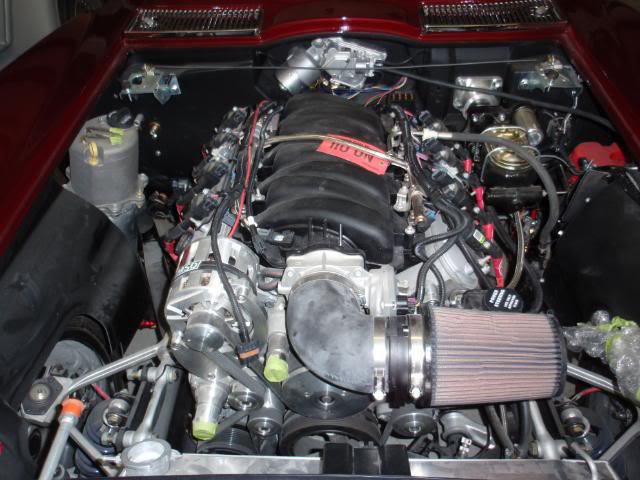
Last edited by poorhousenext; 05-30-2017 at 01:06 PM.
#39
Banned
iTrader: (1)
what sticks out to me is the slowing effect of compression when decelerating. If you shut the engine off and coast in gear the piston still uses energy to compress air, which would subtract from the overall presentation of drivetrain loss%. That means higher compression engines will work harder and have higher loss% displays. It also factors in the throttle position during an engine breaking scenario, as higher cylinder VE during coasting due to larger throttle openings (or IACV valve passages) also means more work is lost compressing air.
If you could shut off the pistons and just have the drivetrain spin down it might work. But there is something else that sticks out to me, the face of the drive gear responsible for acceleration may be different (it probably is) than the face of the same gear used during a decel. So losses while accelerating are probably different due to the shape and design of the gear portion and clearances the transmission uses to accelerate the drivetrain. The difference might be negligible but I still see it as a possible factor.
If you could shut off the pistons and just have the drivetrain spin down it might work. But there is something else that sticks out to me, the face of the drive gear responsible for acceleration may be different (it probably is) than the face of the same gear used during a decel. So losses while accelerating are probably different due to the shape and design of the gear portion and clearances the transmission uses to accelerate the drivetrain. The difference might be negligible but I still see it as a possible factor.
#40
Restricted User
By the way I have an LS7 505 HP GM crate engine installed in car with same "Driveline Components" except "transmission used is a 6L80E an Rear Gear is 3.07 Vs 3.55 in the other one. I also use a LS2 MAF sensor instead of LS3/LS7 one. But it is installed with a 4.0" intake tube feeding the intake. 6L80E has no 1:1 gear as 4th gear is 1.14 to 1 ratio. Same basic exhaust header 1 3/4" tubes, 3.0" exhaust pipes, different mufflers that may flow better of worse that ones on the LS3 powered car.
On same Mustang Dyno, the LS7 make 399 RWHP. 21% of 505 = 398.95 RWHP. I'm fairly sure I can drop that so call Driveline lost some here believe that represents by a minimum of 1% at least by just swapping from LS2 MAF to a LS3/7 style one.
So someone please tell me how I could changed driveline lost by swapping MAF sensor in the intake air system. I did not change the driveline in anyway, only the intake airflow feeding the engine by changed. MY Redneck logic tells me something smells of "a BS smell sales pitch good feeling to explain away lack of HP Bragging number differences".
By the way I can raise the RWHP percentage of the LS3 480HP to same of that of the LS7 505 HP lost. All I have to do is remove that restrictive Dual 3.0" intake tubing and install the air cleaner and 4.0" tube with LS2 MAF in it I use on the LS7 engine. No driveline magic change there, only an engine intake air performance change. Remember the Driveline while almost the same, there are differences in exhaust mufflers, rear gearing and transmission, but the so called drive line lost percentage becomes the same.
The LS7 LS2 MAF intake and air cleaner. Wonder what HP/TQ numbers would be if I could fit one of those high flowing C6 Corvette LS7 air filters in place of that K&N one feeding LS2 MAF...LOL
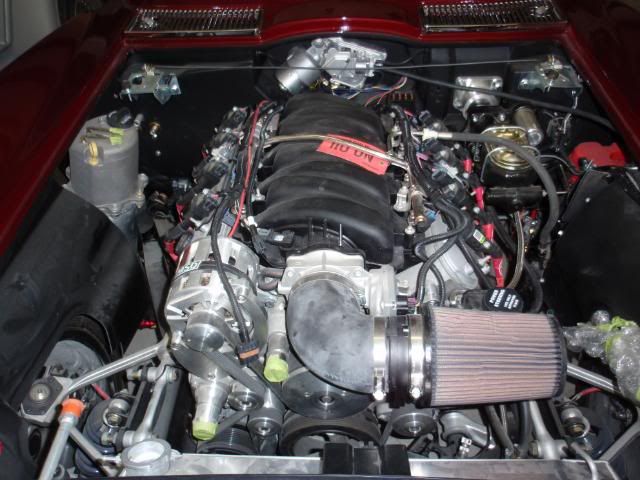
Force = Mass x Acceleration.
Simple physics.
Torque is rotational force. If the Mass of the drivetrain stays the same, then increasing the rate at which it accelerates requires more torque to do so. If you increase power/torque and accelerate the drivetrain at a higher rate, the torque required to do so will increase and will not make it to the rear wheels. The loss will go up. This is why drivetrain loss isn't an exact number, as you cannot defy the laws of physics. This is also why the greater the output, the higher the % loss. You might lose 8% at 2000 RPM, and 25% at 5000 RPM, because your rate of acceleration changes as power increases.
The reason its not a linear % as this formula would dictate is because Power to acceleration isn't linear either. Doubling power does not double the rate at which the drivetrain will accelerate. You don't cut your quarter mile times in half by doubling power. Things like friction, heat, and slip also play major factors here.
Stop with the "Well I used a restrictive filter and this MAF and this muffler and..".
Learn Physics.


